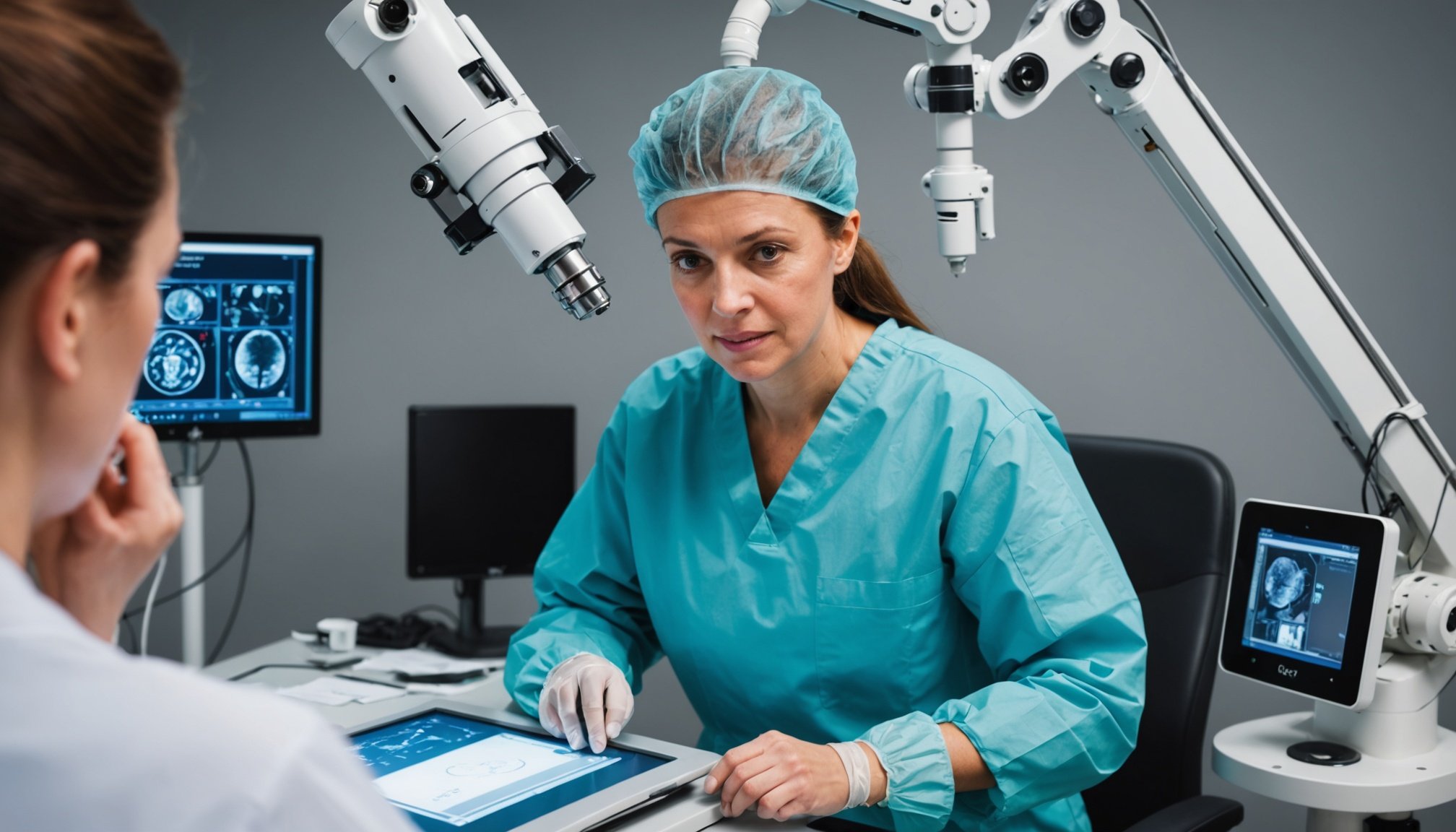Overview of Robotic Surgery in Gynecology
Robotic gynecology is an innovative approach to gynecological surgeries, encompassing procedures performed with advanced robotic systems. These systems provide enhanced precision, allowing surgeons to conduct intricate operations with minimal invasiveness. Such technologies have dramatically transformed the field, offering benefits like reduced recovery times and minimized surgical risks.
Originally emerging in the early 2000s, robotic surgery advancements have marked significant milestones in gynecology. The introduction of the da Vinci Surgical System was a pivotal moment, facilitating complex surgeries such as hysterectomies and myomectomies with greater accuracy. Over the years, technology enhancements have streamlined these operations, making them safer and more accessible.
In the same genre : Exploring Holistic Strategies for UK Veterinarians in Treating Chronic Pet Conditions
In the UK, the adoption of robotic surgery in gynecology has shown a steady increase. Hospitals and clinics recognise the undeniable benefits, integrating these systems into their surgical programs. Though the initial cost can be high, the long-term savings from reduced hospital stays and quicker recoveries have made them appealing options. As of now, many healthcare institutions continue to expand their use, focusing on both accessibility and efficiency in providing cutting-edge care for gynecological patients.
The evolution of robotic gynecology showcases a blend of technological prowess and medical advancement, significantly shaping modern surgical practices.
Have you seen this : Navigating Exotic Pet Health: Strategies for UK Veterinarians in Diagnosing and Treating Imported Animal Diseases
Latest Innovations in Robotic Surgical Systems
In the realm of robotic surgical systems, particularly within gynecology, significant strides have been made. These advanced robotics platforms offer surgeons enhanced capabilities through cutting-edge technological breakthroughs.
Prominent among these innovations is the development of enhanced visualization techniques. Surgeons now have access to high-definition, 3D images that dramatically improve their ability to see intricate anatomical details. This advancement not only increases surgical precision but also minimizes the risk of errors, leading to better patient outcomes.
Another key leap forward is the role of artificial intelligence (AI) and machine learning within these robotic systems. AI algorithms facilitate complex decision-making processes in real time while learning from previous procedures to improve future performance. Machine learning models can predict surgical complications and suggest optimal approaches based on thousands of prior cases, thus increasing the efficiency and safety of procedures.
Moreover, technological innovations have led to the miniaturization of instruments, allowing for less invasive techniques. Smaller incisions mean reduced recovery times and less postoperative pain for patients. Such advances place robotic surgical systems at the forefront of modern surgery, ensuring patient-centric care through enhanced precision and improved safety standards. As these technologies continue to evolve, the future of surgery looks increasingly promising.
Case Studies: Successful Robotic Gynecological Surgeries
Robotic surgery has significantly advanced in the realm of gynecological procedures, showcasing several successful case studies in the UK. These robotic surgery outcomes highlight enhanced precision and reduced recovery times compared to traditional methods.
One notable case involved a patient undergoing a robotic hysterectomy, where the procedure resulted in minimal blood loss and a shortened hospital stay. The patient’s outcome was promising, with a recovery time of just a week, much faster than the 3-6 weeks often associated with traditional surgeries.
Lessons Learned
There are several key lessons from these robotic surgical interventions:
- Precision and Control: The robotic system allows for greater accuracy, reducing complications and enhancing surgical outcomes.
- Reduced Recovery Time: Patients benefit from less invasive procedures, which often result in quicker recovery and minimal scarring.
- Improved Patient Care: The technology provides surgeons with enhanced visibility and access, leading to better overall patient care.
The success stories from these case studies underscore the effectiveness of robotic systems. The data suggests a trend towards adopting this technology more widely, as the positive outcomes resonate with both medical professionals and patients moving towards modern surgical techniques.
Benefits of Robotic Surgery in Gynecology
Robotic surgery’s rise in gynecology has shaped modern medicine, offering significant advantages for both surgeons and patients. One primary benefit is the enhanced precision and control it offers surgeons. Through advanced robotic systems, surgeons can perform procedures that are minimally invasive, resulting in improved patient care.
For Surgeons
- Precision and Control: The dexterity afforded by robotic systems surpasses that of traditional methods. The reduced fatigue experienced due to ergonomic improvements allows surgeons to maintain high performance throughout extended procedures. This level of precision is critical when dealing with delicate areas.
For Patients
Patients undergoing minimally invasive surgery experience notable benefits:
- Shorter Hospital Stays: As the surgery is less invasive, patients often require less time to recover in the hospital, reducing exposure to potential hospital-acquired infections.
- Reduced Pain: Smaller incisions lead to less pain post-operation.
- Faster Recovery: The minimally invasive nature of robotic surgery means that the body can heal more rapidly, allowing patients to resume their daily activities sooner.
Enhanced Surgical Outcomes
Robotic surgery in gynecology has demonstrated lower complication rates, which improves overall surgical outcomes. This forms a compelling argument for adopting robotic systems, aligning with both contemporary patient care expectations and the goals of modern healthcare systems.
Limitations and Challenges of Robotic Surgery
Robotic surgery promises innovative advancements, yet it presents significant challenges in robotic surgery. For instance, the potential complications and risks associated with these surgeries can include operational errors and technical malfunctions. While robotic systems offer precision, they are not immune to glitches, which can lead to unforeseen surgical drawbacks.
The limitations of robotic surgery are not confined to technology alone. One of the pressing concerns involves the high costs and financial implications it poses for healthcare facilities. Investing in robotic systems requires substantial financial resources, potentially burdening smaller institutions. Costs involve not only initial investment but also maintenance and updates of the systems.
Moreover, the need for training and expertise in handling these robotic systems cannot be overstated. Effective utilisation demands rigorous training for surgeons, ensuring they’re adept in manoeuvring the robots accurately. This expertise is crucial to avoid errors that could arise from human oversight in operating complex systems.
Finally, the accessibility of robotic surgery remains a constraint, as it is primarily available in more developed areas, limiting its reach. Strengthening these areas of concern is crucial for the broader adoption and success of robotic surgery.
Training Requirements for Surgeons
Gynaecological surgeons aiming to specialise in robotic surgery require comprehensive training programs that ensure proficiency and competence. Various robotic surgery training programs are meticulously designed to address the educational needs and competency development of surgeons. These programs typically include a blend of theoretical learning, simulation exercises, and hands-on practice.
Simulation plays a pivotal role in surgeon education, allowing practitioners to engage in a controlled and safe environment. Surgeons can practise intricate maneuvers and understand the nuances of robotic techniques without the immediate pressures of real-life operations. This foundational stage builds surgeons’ confidence and is complemented by supervised, hands-on practice on patients.
Beyond skill acquisition, meeting credentialing and certification standards is critical for gaining the trust of patients and peers alike. These standards serve as benchmarks for competency development and ensure surgeons are equipped to handle the unique challenges posed by robotic-assisted procedures. Professional societies and certifying bodies often provide these accreditation processes to maintain a high level of safety and proficiency in the field.
In conclusion, the journey to mastering robotic surgery involves a multi-faceted approach. It combines extensive education, rigorous simulation, practical experience, and stringent certification to deliver top-tier surgical care.
Regulatory Considerations in Robotic Surgery
In the UK, the adoption of robotic surgical systems is governed by a stringent regulatory framework. Key regulatory agencies, such as the Medicines and Healthcare products Regulatory Agency (MHRA), play a pivotal role in overseeing these advanced technologies. These agencies are tasked with ensuring that robotic systems comply with specific medical regulations to safeguard patient safety and efficacy.
Healthcare compliance within this sector demands adherence to a plethora of guidelines and protocols. This includes the validation of robotic systems to meet essential performance and safety standards. Compliance also requires that medical professionals obtain adequate training and certification to operate these systems. The adherence to these comprehensive regulations is crucial to maintaining the integrity and reliability of robotic surgical practices.
The ever-evolving landscape of regulatory framework significantly influences the adoption and utilization of robotic surgery. As regulations adapt to technological advancements, they may either facilitate or impede the integration of these systems into routine surgical procedures. Updates to healthcare compliance protocols can lead to increased adoption by providing clearer pathways for implementation, yet may also present challenges for practitioners needing to stay abreast of changes. Therefore, understanding the interplay between regulatory changes and surgical innovation is key for stakeholders in the robotic surgery field.
Comparison of Robotic Surgery with Traditional Methods
When comparing robotic surgery to traditional methods, several key differences in technique and approach emerge. Traditional surgery often involves larger incisions, allowing surgeons direct access to the operational site. This technique is straightforward but can lead to longer recovery times and increased risk of complications due to more invasive procedures.
In contrast, robotic surgery utilises advanced surgical techniques with precision instruments controlled remotely. The use of robotics minimises incision sizes, offering significant benefits such as reduced recovery times and lower chances of infection. Moreover, robotic systems provide enhanced visualisation and dexterity through articulated instruments, allowing surgeons to perform complex procedures with greater accuracy.
Surgery comparison regarding patient outcomes frequently highlights the advantages of robotic surgery. Patients who undergo robotic procedures often experience less post-operative pain, faster return to normal activities, and higher satisfaction rates compared to those who undergo traditional surgeries.
From the perspective of surgeons, the integration of robotic surgery into practice has been transformative, albeit with a learning curve. Many surgeons find that robotic systems enhance their ability to perform precise operations, expanding the scope of minimally invasive surgery. However, proficiency and comfort with these new technologies require extensive training and adaptation.











